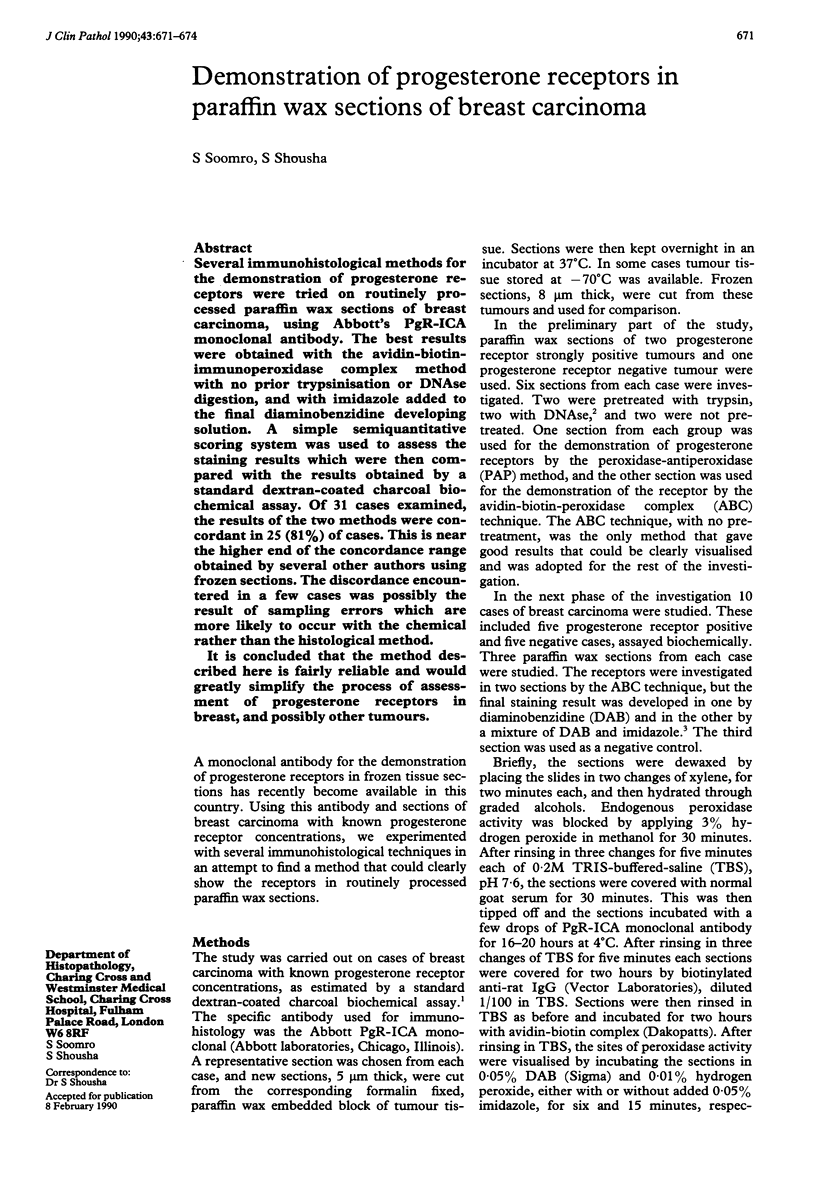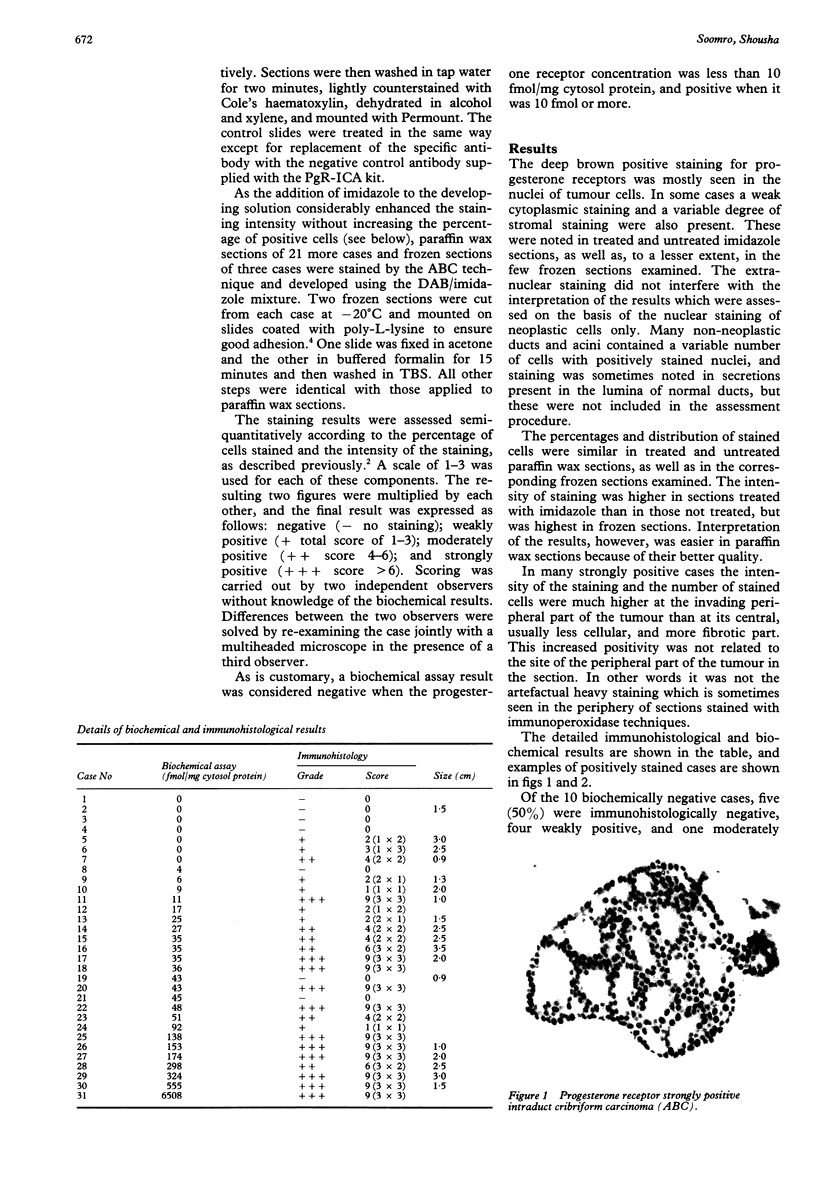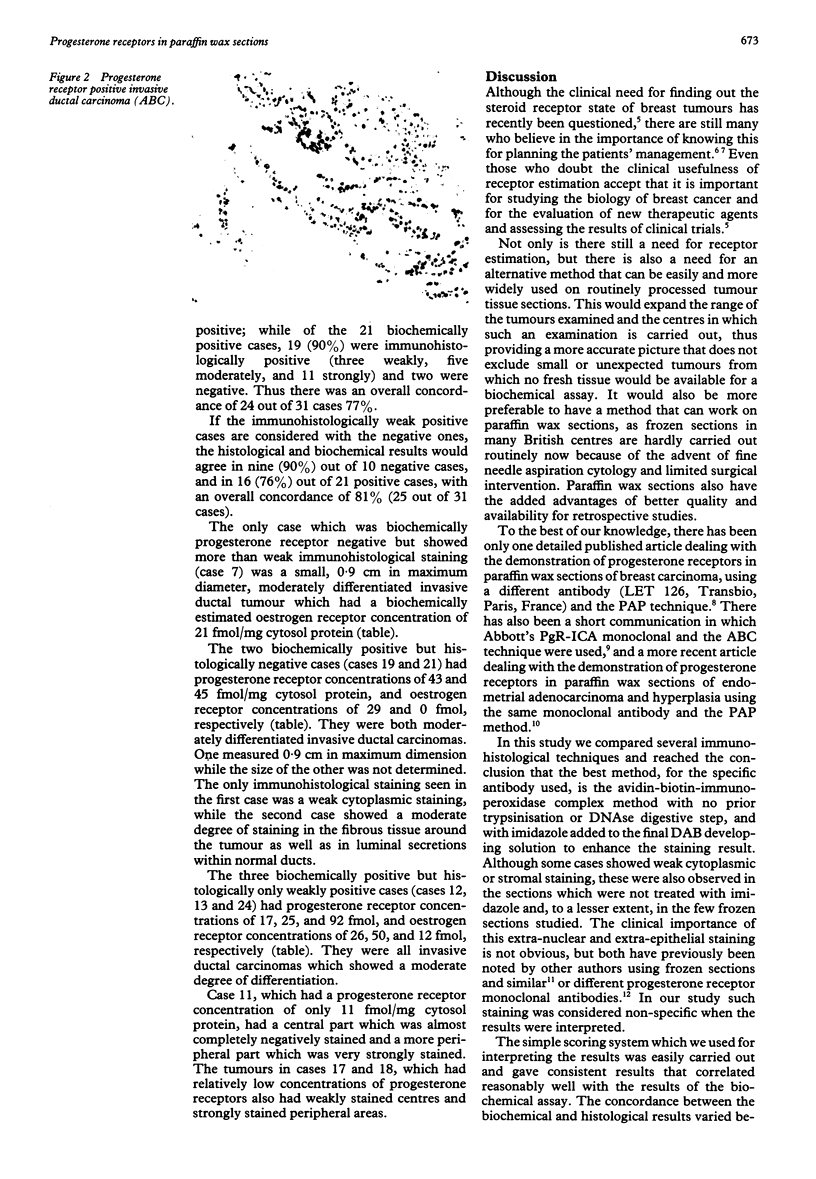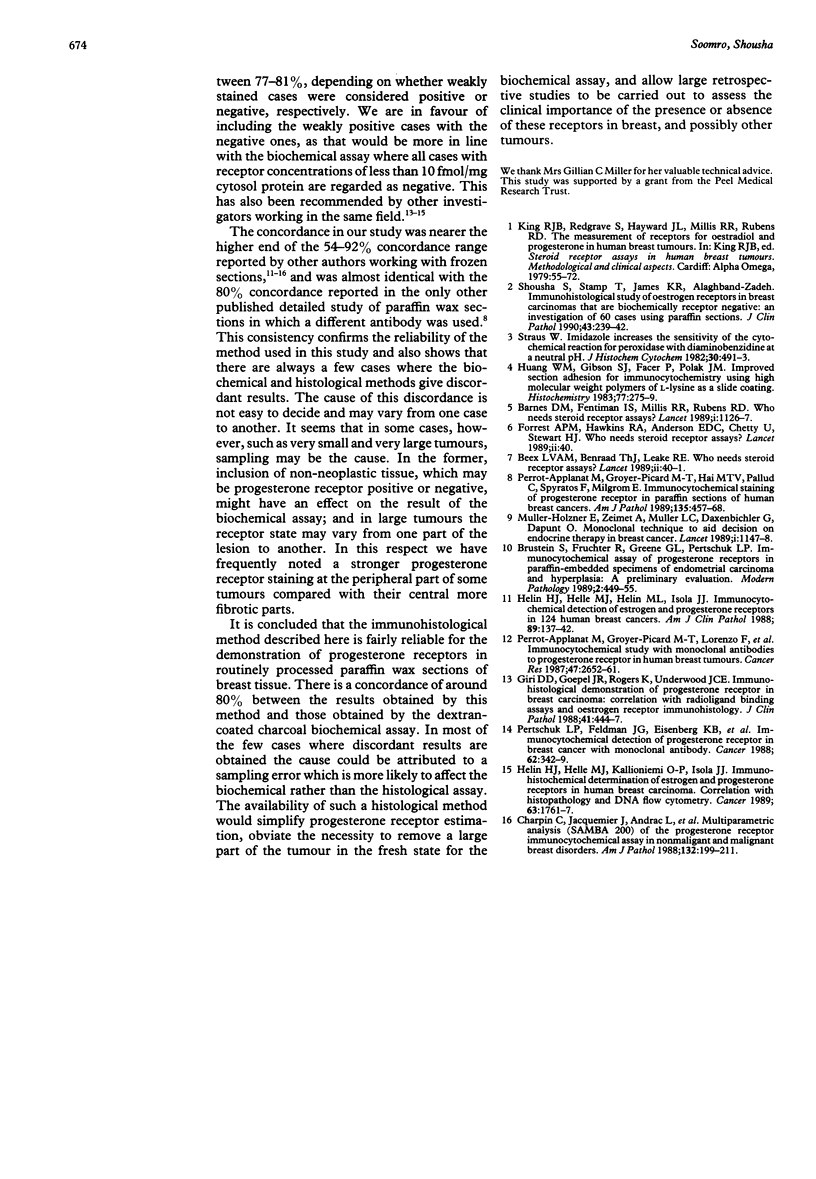Abstract
Several immunohistological methods for the demonstration of progesterone receptors were tried on routinely processed paraffin wax sections of breast carcinoma, using Abbott's PgR-ICA monoclonal antibody. The best results were obtained with the avidin-biotin-immunoperoxidase complex method with no prior trypsinisation or DNAse digestion, and with imidazole added to the final diaminobenzidine developing solution. A simple semiquantitative scoring system was used to assess the staining results which were then compared with the results obtained by a standard dextran-coated charcoal biochemical assay. Of 31 cases examined, the results of the two methods were concordant in 25 (81%) of cases. This is near the higher end of the concordance range obtained by several other authors using frozen sections. The discordance encountered in a few cases was possibly the result of sampling errors which are more likely to occur with the chemical rather than the histological method. It is concluded that the method described here is fairly reliable and would greatly simplify the process of assessment of progesterone receptors in breast, and possibly other tumours.
Full text
PDF



Images in this article
Selected References
These references are in PubMed. This may not be the complete list of references from this article.
- Barnes D. M., Fentiman I. S., Millis R. R., Rubens R. D. Who needs steroid receptor assays? Lancet. 1989 May 20;1(8647):1126–1127. doi: 10.1016/s0140-6736(89)92395-7. [DOI] [PubMed] [Google Scholar]
- Brustein S., Fruchter R., Greene G. L., Pertschuk L. P. Immunocytochemical assay of progesterone receptors in paraffin-embedded specimens of endometrial carcinoma and hyperplasia: a preliminary evaluation. Mod Pathol. 1989 Sep;2(5):449–455. [PubMed] [Google Scholar]
- Charpin C., Jacquemier J., Andrac L., Vacheret H., Habib M. C., Devictor B., Lavaut M. N., Toga M. Multiparametric analysis (SAMBA 200) of the progesterone receptor immunocytochemical assay in nonmalignant and malignant breast disorders. Am J Pathol. 1988 Aug;132(2):199–211. [PMC free article] [PubMed] [Google Scholar]
- Giri D. D., Goepel J. R., Rogers K., Underwood J. C. Immunohistological demonstration of progesterone receptor in breast carcinomas: correlation with radioligand binding assays and oestrogen receptor immunohistology. J Clin Pathol. 1988 Apr;41(4):444–447. doi: 10.1136/jcp.41.4.444. [DOI] [PMC free article] [PubMed] [Google Scholar]
- Helin H. J., Helle M. J., Helin M. L., Isola J. J. Immunocytochemical detection of estrogen and progesterone receptors in 124 human breast cancers. Am J Clin Pathol. 1988 Aug;90(2):137–142. doi: 10.1093/ajcp/90.2.137. [DOI] [PubMed] [Google Scholar]
- Helin H. J., Helle M. J., Kallioniemi O. P., Isola J. J. Immunohistochemical determination of estrogen and progesterone receptors in human breast carcinoma. Correlation with histopathology and DNA flow cytometry. Cancer. 1989 May 1;63(9):1761–1767. doi: 10.1002/1097-0142(19900501)63:9<1761::aid-cncr2820630918>3.0.co;2-3. [DOI] [PubMed] [Google Scholar]
- Huang W. M., Gibson S. J., Facer P., Gu J., Polak J. M. Improved section adhesion for immunocytochemistry using high molecular weight polymers of L-lysine as a slide coating. Histochemistry. 1983;77(2):275–279. doi: 10.1007/BF00506570. [DOI] [PubMed] [Google Scholar]
- Müller-Holzner E., Zeimet A., Müller L. C., Daxenbichler G., Dapunt O. Monoclonal technique to aid decision on endocrine therapy in breast cancer. Lancet. 1989 May 20;1(8647):1147–1148. doi: 10.1016/s0140-6736(89)92435-5. [DOI] [PubMed] [Google Scholar]
- Perrot-Applanat M., Groyer-Picard M. T., Lorenzo F., Jolivet A., Vu Hai M. T., Pallud C., Spyratos F., Milgrom E. Immunocytochemical study with monoclonal antibodies to progesterone receptor in human breast tumors. Cancer Res. 1987 May 15;47(10):2652–2661. [PubMed] [Google Scholar]
- Perrot-Applanat M., Groyer-Picard M. T., Vu Hai M. T., Pallud C., Spyratos F., Milgrom E. Immunocytochemical staining of progesterone receptor in paraffin sections of human breast cancers. Am J Pathol. 1989 Sep;135(3):457–468. [PMC free article] [PubMed] [Google Scholar]
- Pertschuk L. P., Feldman J. G., Eisenberg K. B., Carter A. C., Thelmo W. L., Cruz W. P., Thorpe S. M., Christensen I. J., Rasmussen B. B., Rose C. Immunocytochemical detection of progesterone receptor in breast cancer with monoclonal antibody. Relation to biochemical assay, disease-free survival, and clinical endocrine response. Cancer. 1988 Jul 15;62(2):342–349. doi: 10.1002/1097-0142(19880715)62:2<342::aid-cncr2820620219>3.0.co;2-1. [DOI] [PubMed] [Google Scholar]
- Shousha S., Stamp T., James K. R., Alaghband-Zadeh J. Immunohistological study of oestrogen receptors in breast carcinomas that are biochemically receptor negative. J Clin Pathol. 1990 Mar;43(3):239–242. doi: 10.1136/jcp.43.3.239. [DOI] [PMC free article] [PubMed] [Google Scholar]
- Straus W. Imidazole increases the sensitivity of the cytochemical reaction for peroxidase with diaminobenzidine at a neutral pH. J Histochem Cytochem. 1982 May;30(5):491–493. doi: 10.1177/30.5.6176617. [DOI] [PubMed] [Google Scholar]
- Who needs steroid receptor assays? Lancet. 1989 Jul 1;2(8653):40–41. [PubMed] [Google Scholar]




